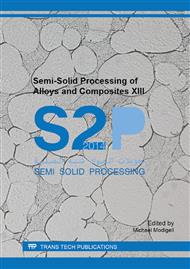p.15
p.23
p.29
p.37
p.45
p.53
p.61
p.67
p.75
Effect of Casting Size on Microstructure and Mechanical Properties of Thixocastings
Abstract:
A general rule in conventional liquid metal casting processes is that smaller size would produce better metallurgical quality and mechanical properties. The conclusion that semi-solid thixocasting process doesnt follow this rule has been made recently. The microstructure and mechanical properties of semi-solid thixocastings are much less dependent on casting size and cooling rate than the liquid castings. The step casting in the previous study is specially designed and simplified. The practical castings, e.g. turbocharger impellers, are more complex than the step castings. In this work, the turbocharger impeller is used to study the impact of section size representing the casting size on the microstructure and mechanical properties of semi-solid thixocastings, compared with the step casting. Section thickness decreases from 50 mm to 3.5 mm. In addition, the impact of casting thickness on the eutectic phase is also presented. The results reveal that the size of primary α-Al particles is insensitive to the casting thickness in semi-solid thixocasting. The cooling rate has a notable impact on the size and geometric characteristics of the eutectic silicon particles, but the impact is reduced by the following T61 heat treatment. The association between the casting thickness and casting defects is discussed, in order to further understand the impact of casting size on durability and reliability of real casting components.
Info:
Periodical:
Pages:
45-52
Citation:
Online since:
September 2014
Authors:
Price:
Сopyright:
© 2015 Trans Tech Publications Ltd. All Rights Reserved
Share:
Citation:


